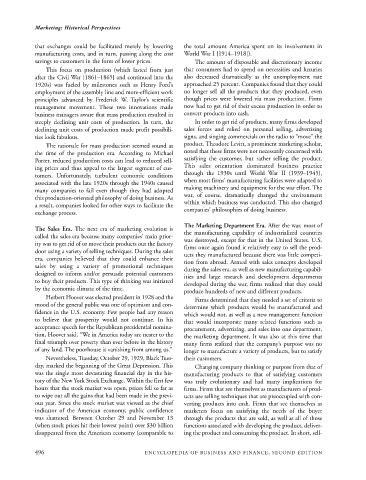Page 519 - Encyclopedia of Business and Finance
P. 519
eobf_M 7/5/06 3:15 PM Page 496
Marketing: Historical Perspectives
that exchanges could be facilitated merely by lowering the total amount America spent on its involvement in
manufacturing costs, and in turn, passing along the cost World War I [1914–1918]).
savings to customers in the form of lower prices. The amount of disposable and discretionary income
This focus on production (which lasted from just that consumers had to spend on necessities and luxuries
after the Civil War [1861–1865] and continued into the also decreased dramatically as the unemployment rate
1920s) was fueled by milestones such as Henry Ford’s approached 25 percent. Companies found that they could
employment of the assembly line and more-efficient work no longer sell all the products that they produced, even
principles advanced by Frederick W. Taylor’s scientific though prices were lowered via mass production. Firms
management movement. These two innovations made now had to get rid of their excess production in order to
business managers aware that mass production resulted in convert products into cash.
steeply declining unit costs of production. In turn, the In order to get rid of products, many firms developed
declining unit costs of production made profit possibili- sales forces and relied on personal selling, advertising
ties look fabulous. signs, and singing commercials on the radio to “move” the
The rationale for mass production seemed sound at product. Theodore Levitt, a prominent marketing scholar,
the time of the production era. According to Michael noted that these firms were not necessarily concerned with
Porter, reduced production costs can lead to reduced sell- satisfying the customer, but rather selling the product.
ing prices and thus appeal to the largest segment of cus- This sales orientation dominated business practice
tomers. Unfortunately, turbulent economic conditions through the 1930s until World War II (1939–1945),
associated with the late 1920s through the 1940s caused when most firms’ manufacturing facilities were adapted to
many companies to fail even though they had adopted making machinery and equipment for the war effort. The
war, of course, dramatically changed the environment
this production-oriented philosophy of doing business. As
within which business was conducted. This also changed
a result, companies looked for other ways to facilitate the
companies’ philosophies of doing business.
exchange process.
The Marketing Department Era. After the war, most of
The Sales Era. The next era of marketing evolution is
the manufacturing capability of industrialized countries
called the sales era because many companies’ main prior-
was destroyed, except for that in the United States. U.S.
ity was to get rid of or move their products out the factory
firms once again found it relatively easy to sell the prod-
door using a variety of selling techniques. During the sales
ucts they manufactured because there was little competi-
era, companies believed that they could enhance their tion from abroad. Armed with sales concepts developed
sales by using a variety of promotional techniques during the sales era, as well as new manufacturing capabil-
designed to inform and/or persuade potential customers ities and large research and development departments
to buy their products. This type of thinking was initiated developed during the war, firms realized that they could
by the economic climate of the time.
produce hundreds of new and different products.
Herbert Hoover was elected president in 1928 and the Firms determined that they needed a set of criteria to
mood of the general public was one of optimism and con-
determine which products would be manufactured and
fidence in the U.S. economy. Few people had any reason
which would not, as well as a new management function
to believe that prosperity would not continue. In his
that would incorporate many related functions such as
acceptance speech for the Republican presidential nomina- procurement, advertising, and sales into one department,
tion, Hoover said, “We in America today are nearer to the the marketing department. It was also at this time that
final triumph over poverty than ever before in the history many firms realized that the company’s purpose was no
of any land. The poorhouse is vanishing from among us.” longer to manufacture a variety of products, but to satisfy
Nevertheless, Tuesday, October 29, 1929, Black Tues- their customers.
day, marked the beginning of the Great Depression. This Changing company thinking or purpose from that of
was the single most devastating financial day in the his- manufacturing products to that of satisfying customers
tory of the New York Stock Exchange. Within the first few was truly evolutionary and had many implications for
hours that the stock market was open, prices fell so far as firms. Firms that see themselves as manufacturers of prod-
to wipe out all the gains that had been made in the previ- ucts use selling techniques that are preoccupied with con-
ous year. Since the stock market was viewed as the chief verting products into cash. Firms that see themselves as
indicator of the American economy, public confidence marketers focus on satisfying the needs of the buyer
was shattered. Between October 29 and November 13 through the products that are sold, as well as all of those
(when stock prices hit their lowest point) over $30 billion functions associated with developing the product, deliver-
disappeared from the American economy (comparable to ing the product and consuming the product. In short, sell-
496 ENCYCLOPEDIA OF BUSINESS AND FINANCE, SECOND EDITION

